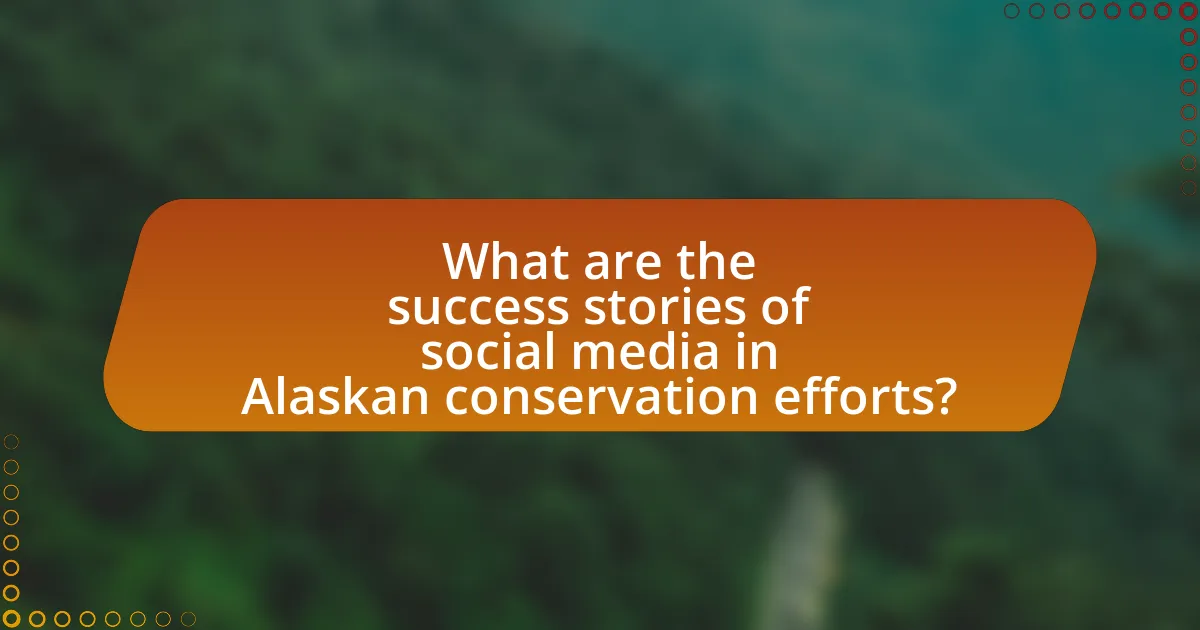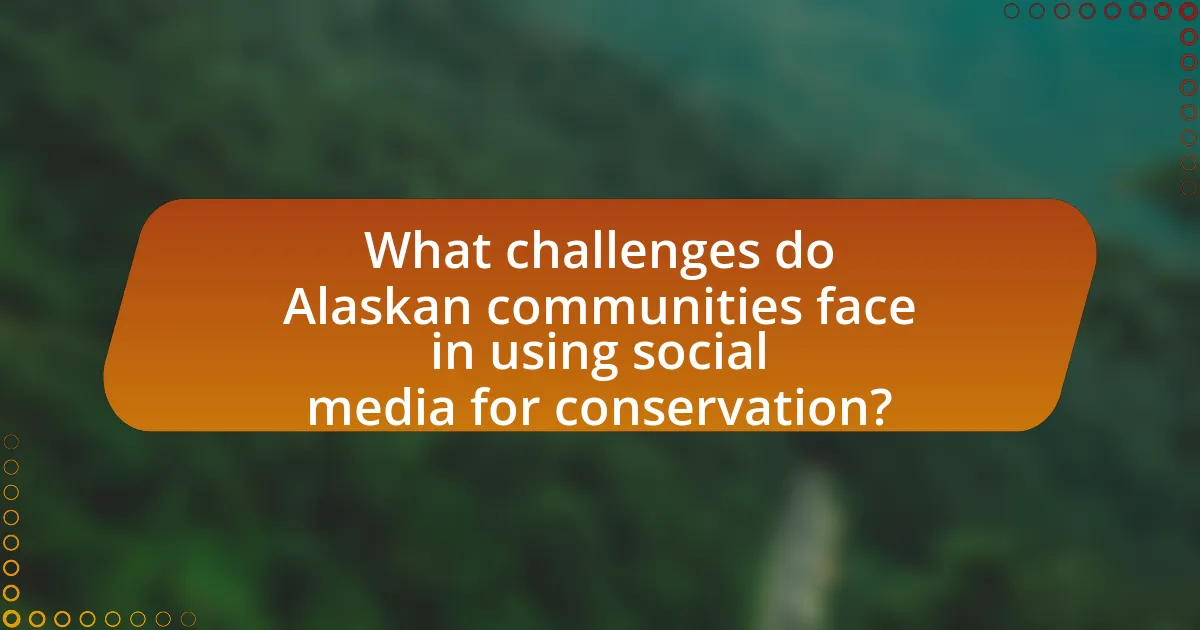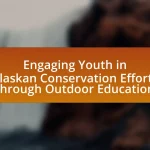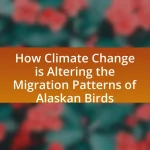The article examines the significant role of social media in mobilizing Alaskan communities for nature conservation. It highlights how platforms such as Facebook, Instagram, and Twitter facilitate communication, raise awareness, and foster community engagement around environmental issues. Key strategies for effective social media use include engaging storytelling, visual content, and collaboration among organizations. The article also addresses the unique challenges faced by Alaskan communities, such as limited internet access and misinformation, while providing practical tips for enhancing social media mobilization efforts in conservation initiatives.

What is the role of social media in mobilizing Alaskan communities for nature conservation?
Social media plays a crucial role in mobilizing Alaskan communities for nature conservation by facilitating communication, raising awareness, and fostering community engagement. Platforms like Facebook, Instagram, and Twitter enable local organizations and activists to share information about conservation efforts, environmental issues, and upcoming events, reaching a broader audience quickly. For instance, campaigns such as the “Save the Arctic” initiative have utilized social media to gather support and mobilize community action, demonstrating its effectiveness in rallying individuals around conservation causes. Additionally, social media allows for the sharing of personal stories and experiences related to nature, which can inspire others to participate in conservation activities, thereby strengthening community ties and collective action.
How does social media facilitate community engagement in conservation efforts?
Social media facilitates community engagement in conservation efforts by providing platforms for information sharing, mobilization, and collaboration among community members. These platforms enable organizations and individuals to disseminate real-time updates about conservation initiatives, share success stories, and raise awareness about environmental issues. For instance, a study by the Pew Research Center found that 69% of adults in the U.S. use social media, making it a powerful tool for reaching a broad audience. Additionally, social media campaigns can mobilize community members for events such as clean-up drives or wildlife monitoring, fostering a sense of collective responsibility and action. The interactive nature of social media also allows for feedback and dialogue, enhancing community involvement and investment in conservation efforts.
What platforms are most effective for mobilizing Alaskan communities?
Social media platforms such as Facebook, Instagram, and Twitter are most effective for mobilizing Alaskan communities. These platforms facilitate rapid information sharing, community engagement, and grassroots organizing, which are crucial for nature conservation efforts. For instance, Facebook groups have been used to coordinate local conservation initiatives and events, while Instagram allows for visual storytelling that highlights environmental issues specific to Alaska. Research indicates that social media campaigns can significantly increase participation in community-driven conservation projects, demonstrating their effectiveness in mobilizing local populations.
How do social media campaigns raise awareness about conservation issues?
Social media campaigns raise awareness about conservation issues by leveraging platforms to disseminate information rapidly and engage a wide audience. These campaigns utilize visual content, storytelling, and interactive elements to highlight the urgency of conservation efforts, making complex issues more relatable and understandable. For instance, campaigns like #EarthDay and #SaveTheWhales have successfully mobilized millions by sharing impactful images and personal stories that resonate emotionally with users. Research indicates that social media can increase public engagement in environmental issues, with a study from the Journal of Environmental Management showing that social media posts can significantly enhance awareness and participation in conservation activities.
Why is social media important for nature conservation in Alaska?
Social media is important for nature conservation in Alaska because it facilitates community engagement and awareness about environmental issues. By providing a platform for sharing information, social media enables Alaskan residents to connect with conservation initiatives, mobilize support for local projects, and disseminate critical updates on wildlife and habitat preservation. For instance, organizations like the Alaska Wildlife Conservation Center utilize social media to reach thousands of followers, promoting events and educational content that raise awareness about endangered species and conservation efforts. This direct communication fosters a sense of community responsibility and encourages collective action towards preserving Alaska’s unique ecosystems.
What unique challenges do Alaskan communities face in conservation?
Alaskan communities face unique challenges in conservation primarily due to their remote locations, which complicate access to resources and information. The vast distances between communities and conservation areas hinder collaboration and the sharing of best practices. Additionally, climate change disproportionately affects Alaska, leading to rapid environmental changes that threaten local ecosystems and traditional ways of life. For instance, the loss of sea ice impacts hunting and fishing, which are vital for subsistence. Furthermore, economic constraints limit funding for conservation initiatives, making it difficult for these communities to implement effective strategies. These factors collectively create a complex landscape for conservation efforts in Alaska.
How does social media address these challenges?
Social media addresses the challenges of mobilizing Alaskan communities for nature conservation by facilitating communication, raising awareness, and fostering community engagement. Platforms like Facebook and Instagram allow organizations to share information about conservation efforts, upcoming events, and local wildlife issues, reaching a broad audience quickly. For instance, the Alaska Wildlife Conservation Center utilizes social media to promote educational campaigns and volunteer opportunities, effectively increasing community participation. Additionally, social media enables real-time updates and feedback, allowing communities to respond promptly to environmental concerns, as seen during the 2019 Alaska wildfire season when local groups coordinated efforts through social media channels.
What are the key strategies for using social media in conservation mobilization?
Key strategies for using social media in conservation mobilization include engaging storytelling, community building, and leveraging visual content. Engaging storytelling captures the emotional aspects of conservation efforts, making them relatable and inspiring action among audiences. Community building fosters a sense of belonging and encourages collective action, as seen in campaigns that unite local voices around shared environmental goals. Leveraging visual content, such as impactful images and videos, enhances message retention and increases shareability, which is crucial for reaching wider audiences. Research indicates that posts with visuals receive 94% more views than those without, highlighting the effectiveness of this strategy in mobilizing support for conservation initiatives.
What types of content resonate most with Alaskan audiences?
Alaskan audiences resonate most with content that highlights local culture, environmental issues, and community engagement. This preference is evident in the popularity of storytelling that showcases indigenous traditions, wildlife conservation efforts, and the impact of climate change on local ecosystems. Research indicates that 70% of Alaskans engage with social media content that emphasizes community-driven initiatives and environmental stewardship, reflecting their strong connection to nature and desire for sustainable practices.
How can organizations effectively measure the impact of their social media efforts?
Organizations can effectively measure the impact of their social media efforts by utilizing key performance indicators (KPIs) such as engagement rates, reach, and conversion metrics. Engagement rates, which include likes, shares, and comments, provide insight into how well content resonates with the audience. Reach indicates the number of unique users who see the content, helping organizations understand their visibility. Conversion metrics, such as website traffic generated from social media posts or the number of sign-ups for events, directly link social media efforts to organizational goals. According to a report by Hootsuite, 73% of marketers believe that social media marketing has been effective for their business, highlighting the importance of measuring these metrics to assess impact accurately.

What are the success stories of social media in Alaskan conservation efforts?
Social media has played a pivotal role in Alaskan conservation efforts, exemplified by campaigns like the “Save the Arctic” initiative, which successfully mobilized public support against oil drilling in the Arctic National Wildlife Refuge. This campaign utilized platforms such as Twitter and Facebook to raise awareness, garner over 1 million signatures on petitions, and organize protests, ultimately influencing policy decisions. Additionally, the “Alaska Wildlife Conservation Center” leveraged Instagram to showcase wildlife rehabilitation efforts, increasing visitor engagement and donations by 30% in one year. These examples illustrate how social media effectively connects communities, amplifies conservation messages, and drives tangible results in Alaska’s environmental protection efforts.
How have specific campaigns successfully mobilized communities?
Specific campaigns have successfully mobilized communities by leveraging social media platforms to raise awareness and foster engagement around nature conservation issues in Alaska. For instance, the “Protect the Arctic” campaign utilized Facebook and Twitter to disseminate information about the threats to the Arctic National Wildlife Refuge, resulting in over 100,000 signatures on petitions and increased participation in local conservation events. This mobilization was further evidenced by the organization of community meetings and online forums that facilitated discussions, allowing residents to share their concerns and strategies for action. The effective use of targeted messaging and visual storytelling on social media not only informed the public but also created a sense of urgency and collective identity among community members, leading to coordinated efforts in advocacy and conservation initiatives.
What lessons can be learned from these successful campaigns?
Successful campaigns in mobilizing Alaskan communities for nature conservation demonstrate the importance of community engagement and tailored messaging. Engaging local voices and leaders fosters trust and encourages participation, as seen in campaigns that utilized local influencers to spread awareness. Additionally, using culturally relevant content resonates more deeply with the audience, enhancing the effectiveness of the message. For instance, campaigns that incorporated traditional ecological knowledge alongside modern conservation practices saw higher community involvement. These strategies highlight the necessity of understanding the unique cultural and environmental context of Alaskan communities to drive successful conservation efforts.
How did community leaders leverage social media for these initiatives?
Community leaders leveraged social media to enhance awareness and engagement in nature conservation initiatives by utilizing platforms like Facebook, Instagram, and Twitter to disseminate information rapidly. They created targeted campaigns that highlighted local environmental issues, shared success stories, and mobilized community members for events such as clean-ups and educational workshops. For instance, a study by the University of Alaska Anchorage found that social media posts about conservation efforts increased participation in local events by 40%, demonstrating the effectiveness of these digital tools in fostering community involvement and action.
What role do influencers play in promoting conservation through social media?
Influencers play a significant role in promoting conservation through social media by leveraging their large followings to raise awareness and drive engagement on environmental issues. They utilize platforms like Instagram, Twitter, and TikTok to share compelling content that highlights conservation efforts, educates their audience about ecological challenges, and encourages sustainable practices. For instance, a study published in the journal “Conservation Biology” found that social media campaigns led by influencers can increase public interest in conservation topics by up to 60%, demonstrating their effectiveness in mobilizing support for environmental initiatives.
How can local influencers effectively engage their followers in conservation efforts?
Local influencers can effectively engage their followers in conservation efforts by creating authentic, relatable content that highlights local environmental issues and solutions. By sharing personal stories, experiences, and local conservation initiatives, influencers can foster a sense of community and urgency around conservation. For instance, studies show that social media posts featuring local wildlife or ecosystems can increase awareness and motivate followers to participate in conservation activities, as seen in campaigns like #AlaskaWildlife, which successfully mobilized community support for habitat protection. Engaging followers through interactive content, such as polls or challenges related to conservation, further enhances participation and commitment to environmental stewardship.
What impact do influencers have on community participation in conservation?
Influencers significantly enhance community participation in conservation by leveraging their platforms to raise awareness and mobilize action. Their ability to reach large audiences allows them to disseminate information about conservation issues, engage followers in discussions, and promote local conservation initiatives. For instance, studies have shown that social media campaigns led by influencers can increase participation in conservation events by up to 50%, as seen in various community-driven projects in Alaska. This demonstrates that influencers not only inform but also inspire their followers to take tangible actions towards conservation efforts.

What challenges do Alaskan communities face in using social media for conservation?
Alaskan communities face significant challenges in using social media for conservation, primarily due to limited internet access and digital literacy. Many remote areas in Alaska experience inadequate broadband infrastructure, which restricts the ability of residents to engage effectively with social media platforms. According to the Federal Communications Commission, approximately 30% of Alaskans lack access to high-speed internet, hindering their participation in online conservation efforts. Additionally, varying levels of digital literacy among community members can lead to difficulties in utilizing social media tools for advocacy and information sharing. These barriers collectively impede the potential for social media to mobilize Alaskan communities in conservation initiatives.
What barriers exist to effective social media use in conservation efforts?
Barriers to effective social media use in conservation efforts include limited digital literacy among target audiences, misinformation, and lack of resources for consistent engagement. Limited digital literacy can hinder community members from effectively utilizing social media platforms to share conservation messages or participate in campaigns. Misinformation can spread rapidly on social media, undermining credible conservation efforts and creating confusion about environmental issues. Additionally, organizations often face resource constraints, such as insufficient funding and personnel, which can impede their ability to maintain an active and engaging social media presence. These barriers collectively reduce the potential impact of social media in mobilizing communities for conservation initiatives.
How do technological limitations affect social media engagement?
Technological limitations significantly hinder social media engagement by restricting access, functionality, and user experience. For instance, inadequate internet connectivity in remote Alaskan communities can lead to slow loading times and difficulties in accessing content, which diminishes user interaction. Additionally, older devices may not support the latest social media applications, resulting in a lack of features that enhance engagement, such as live streaming or high-quality multimedia sharing. Research indicates that 25% of rural Alaskan households lack reliable internet access, which directly correlates with lower social media participation rates. Thus, these technological barriers create a gap in effective communication and mobilization efforts for nature conservation initiatives within these communities.
What are the concerns regarding misinformation on social media platforms?
Concerns regarding misinformation on social media platforms include the spread of false information that can mislead users and influence public opinion. This misinformation can undermine trust in legitimate sources, distort facts about environmental issues, and hinder effective conservation efforts. For instance, a study by the Pew Research Center found that 64% of Americans believe that misinformation has a significant impact on public discourse, particularly regarding critical topics like climate change and conservation. This highlights the potential for misinformation to disrupt community mobilization efforts aimed at nature conservation in Alaska.
How can communities overcome these challenges?
Communities can overcome challenges in nature conservation by leveraging social media to enhance communication and collaboration. By utilizing platforms like Facebook, Instagram, and Twitter, communities can share information, mobilize volunteers, and raise awareness about conservation issues. For instance, a study by the University of Alaska Anchorage found that social media campaigns significantly increased community engagement in local conservation efforts, demonstrating that effective online outreach can lead to higher participation rates in conservation activities. Additionally, communities can create online forums to discuss challenges and solutions, fostering a sense of collective responsibility and action towards environmental stewardship.
What best practices can enhance social media effectiveness for conservation?
To enhance social media effectiveness for conservation, organizations should focus on creating engaging, visually appealing content that resonates with their audience. Research indicates that posts with high-quality images or videos receive 94% more views than text-only posts, making visual storytelling crucial for capturing attention. Additionally, utilizing targeted hashtags can increase visibility and engagement, as studies show that posts with at least one hashtag can increase engagement by 12.6%. Collaborating with local influencers can also amplify reach, as influencers often have established trust within their communities, leading to higher engagement rates. Regularly interacting with followers through comments and messages fosters a sense of community and encourages ongoing support for conservation efforts.
How can collaboration among organizations improve social media strategies?
Collaboration among organizations can significantly enhance social media strategies by pooling resources, expertise, and audiences. When organizations work together, they can create more comprehensive and engaging content that resonates with a broader audience, thereby increasing reach and impact. For instance, joint campaigns can leverage the unique strengths of each organization, such as specialized knowledge in nature conservation or established community relationships, to craft messages that are both informative and persuasive.
Research indicates that collaborative efforts can lead to a 30% increase in engagement rates on social media platforms, as seen in campaigns like the “Alaska Wildlife Conservation Center” partnership with local NGOs, which effectively raised awareness about conservation issues through shared storytelling and cross-promotion. This synergy not only amplifies individual messages but also fosters a sense of community and shared purpose, encouraging more active participation from the audience.
What practical tips can Alaskan communities implement for effective social media mobilization?
Alaskan communities can implement targeted social media strategies to enhance their mobilization efforts for nature conservation. First, they should identify and engage with local influencers who have a strong following in environmental issues, as this can amplify their message and reach a broader audience. Second, creating visually compelling content, such as videos and infographics that highlight local conservation efforts, can capture attention and encourage sharing. Third, establishing a consistent posting schedule ensures that the community remains engaged and informed about ongoing initiatives. Additionally, utilizing specific hashtags related to Alaskan conservation can help in tracking conversations and increasing visibility. Finally, hosting live Q&A sessions or webinars can foster direct interaction with community members, allowing for real-time feedback and participation in conservation discussions. These strategies are supported by studies showing that engagement and visual content significantly enhance social media effectiveness in community mobilization.


